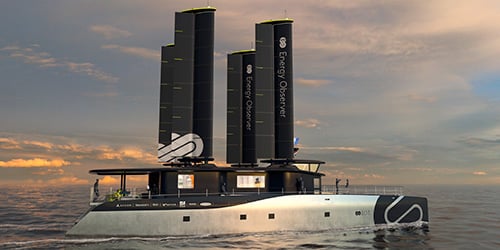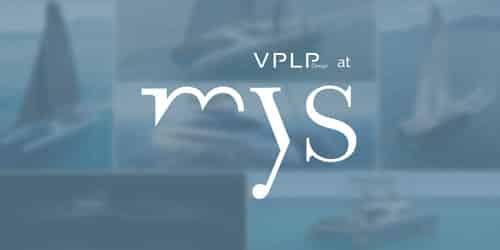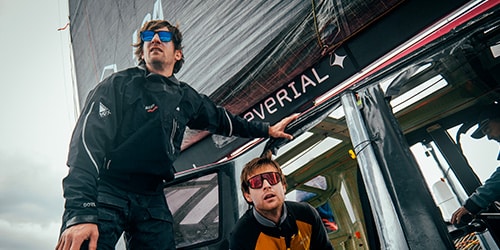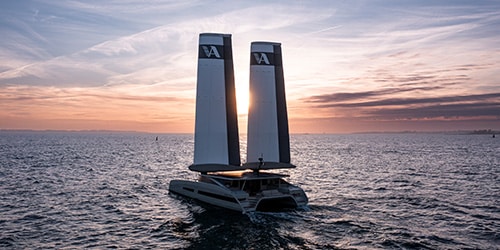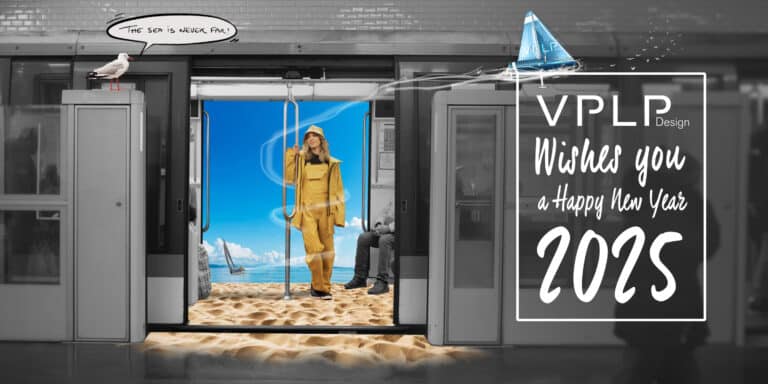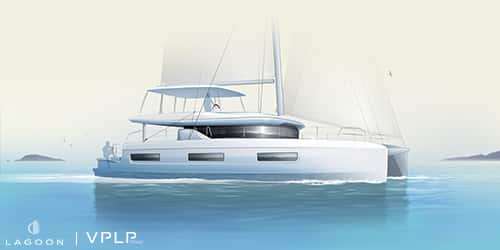VPLP Design’s collaboration with the Luna Rossa Team wasn’t limited to the conception and design of the Italian racing syndicate’s chase boat (see last October’s newsletter). In the autumn of 2021, VPLP engineer Adrien Letourneur joined the runners-up of the Louis Vuitton Cup on secondment for three years as the team’s appendage designer. Tasked with a coordinating role, Adrien recounts his very instructive Italian adventure in the company of Xavier Guisnel, lead engineering coordinator at VPLP Design.
“In September 2021, I had barely the time to send off the cutting files for Malizia Seaexplorer’s foils before shooting off to Sardinia to join Luna Rossa. For the first year I commuted back and forth until I moved the family out to Cagliari in the summer of 2022,” explains Adrien Letourneur. Graduating from ENSTA Paris in 2014, Adrien joined VPLP Design a year later at a time when foils and foiling became a central preoccupation of offshore racing. He decided to specialize in designing appendages and his subsequent work has included the trimarans Banque Populaire IX and XI and the IMOCAs Charal 1 and Malizia Seaexplorer, the latter launching in July 2022. “I experienced the period when VPLP was developing computational tools and working methods which allowed us to acquire a veritable expertise in foil design.” Over the following decade Adrien became a very experienced appendage designer.
His proven track record as a specialist and coordinator was exactly what Max Sirena, Team Director of Luna Rossa, was looking for when he contacted VPLP in 2021. With the trend towards the expansion of design teams, each racing syndicate is looking for the right person with very precise skills rather than farming out work to agencies. . “In the case of Luna Rossa, the deal focused on the person of Adrien and the design tools developed by VPLP, and a very strict non-disclosure agreement. Adrien is a master calculator of fluid-structure interactions. He also possesses a great understanding of hydrodynamics and structural mechanics, two fields which rarely find a home in the same engineer. Since working at VPLP, Adrien has acquired a veritable expertise in the mechanics of fluids circulating around lifting surfaces,” explains Xavier Guisnel.
At Cagliari, Adrien Letourneur was given the position of lead appendage designer in a wider design team of about forty people. “In general, teams have very few multidisciplinary profiles. However when you work in appendages you can’t have a narrow focus because you need to be able to talk to a wide range of specialists,” he says. While in offshore racing 80% of the foil design work is done by an architect, when it comes to the America’s Cup, appendages are the result of a considerable coordinated effort. “This comes from the flight-only nature of the AC75s, of course, but also from the fact that parts of the appendage control systems are embedded into its structure. What’s more, weight is rounded up or down to the nearest kilogram. This complicates the design enormously compared to offshore racing where the systems are in the hull,” adds Adrien Letourneur.

Countless foils simulations!

Many mathematical design tools were developed in-house and the three years spent with the team were punctuated with the dispatching of shapes and the “output” of the four test foils authorized by Cup rules. “We developed an entire suite of tools to evaluate the principal performance criteria of a foil: performance in a straight line and when turning, ease of use for the sailors, efficiency during take off, cavitation at high speeds… These tools communicate with each other and create a workflow to develop the design spirals,” explains the engineer. In the end, they ran countless foil simulations: “sometimes the changes were minimal from one version to the next!”
Were the teams surprised by their rival’s appendages when they got to Barcelona? “Not that much,” says Adrien. “Thanks to Recon [the supervised espionage programme that, up until last summer, gave access to a vast amount of data on the other challenges], we had an overview of each team’s foil iterations. Obviously, surface areas and thicknesses were not part of the revealed data but we could recognize each other’s hand.”
Adrien Letourneur returned to VPLP last autumn and is now designing appendages for Ultim trimarans. According to Xavier Guisnel, regardless of the results of this edition of the Cup, the experience that Adrien acquired is invaluable: “Working for three years on a single subject in such fine detail is pretty unique. Joining a large and very international team which gives you the resources to undertake all sorts of research is going to enlarge considerably your spectrum of ideas! And of course, everyone at the firm will benefit from everything he has learned. Sharing our experiences means everyone progresses. It’s a fusion of collective knowledge.”

